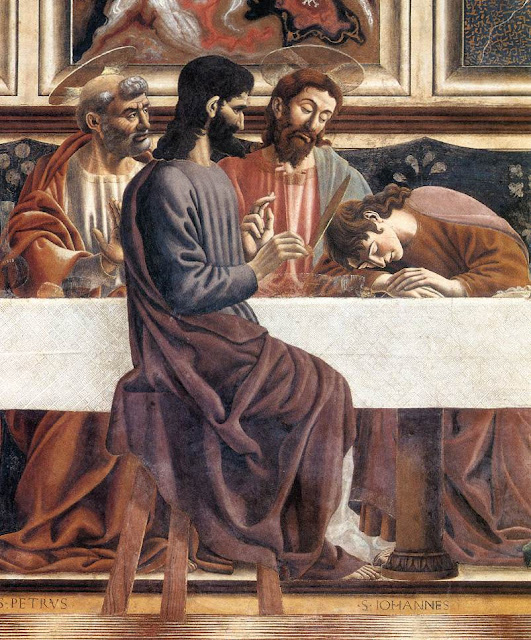 |
|
Andrea dal Castagno, Last Supper and Stories of
Christ's Passion, 1447, Fresco, 453 x 975 cm (each fresco), Sant'Apollonia,
Florence.
|
Andrea dal Castagno’s origins have always been shrouded in
mystery. On the one hand he said to be the son of a poor labourer in Castagno, just
outside Florence; on the other he’s supposed to have held land in that district.
Much worse than this, due to Vasari, Andrea’s character was besmirched for over
four hundred years because his biographer alleged that Castagno had “murdered”
another famous painter, Domenico Veneziano, a distortion that was retold by
every Florentine commentator after Vasari.[1]
The assassination theory has subsequently been disproved as it is known that
Veneziano survived Andrea by four years. Andrea’s future became brighter when
he came under the protection of the Florentine nobleman, Bernadetto de’ Medici,
and eventually gained the nickname “Andrea degli Impiccati” (“Little Andrea of
the Hanged Men”) because he painted the faces of the traitors in the Pazzi
conspiracy on the walls of the Senate House. In 1442 he worked with Francesco
di Faenza on frescoes in S. Zaccaria in Venice before returning to Florence in
1444. His first great work was a Last Supper and Scenes from the Life
of Christ for the Convent of St Apollonia in Florence, which now serves as
a museum for the painter. Other notable works include a Crucifixion (NG,
London), a panel of the Young David (NG, Washington), and a Trinity
with a foreshortened, airborne Christ. A sinopia drawing for the Trinity could
hardly be more different from the fresco: the figures do not have their backs
to the viewer; instead of a rugged, toothless old man, we have a more agile
younger man. The spectacular trinity is barely indicated in the sinopia
drawing; and as Millard Meiss points out, the foreshortening caused Andrea much
trouble. After painting the lower part of Christ’s body in awkward
foreshortening, he decided to conceal this with a group of angels. This
addition was painted a secco, so the paint peeled, and so we can see Andrea’s
heroic efforts to capture this effect.[2]
 |
|
Andrea dal Castagno the Holy Trinity, St Jerome
and Two Saints, c. 1453, Fresco, Santissima Annunziata, Florence.
|
 |
|
Andrea dal Castagno, Sinopia drawing for Holy
Trinity, Santissima Annunziata, Florence.
|





No comments:
Post a Comment